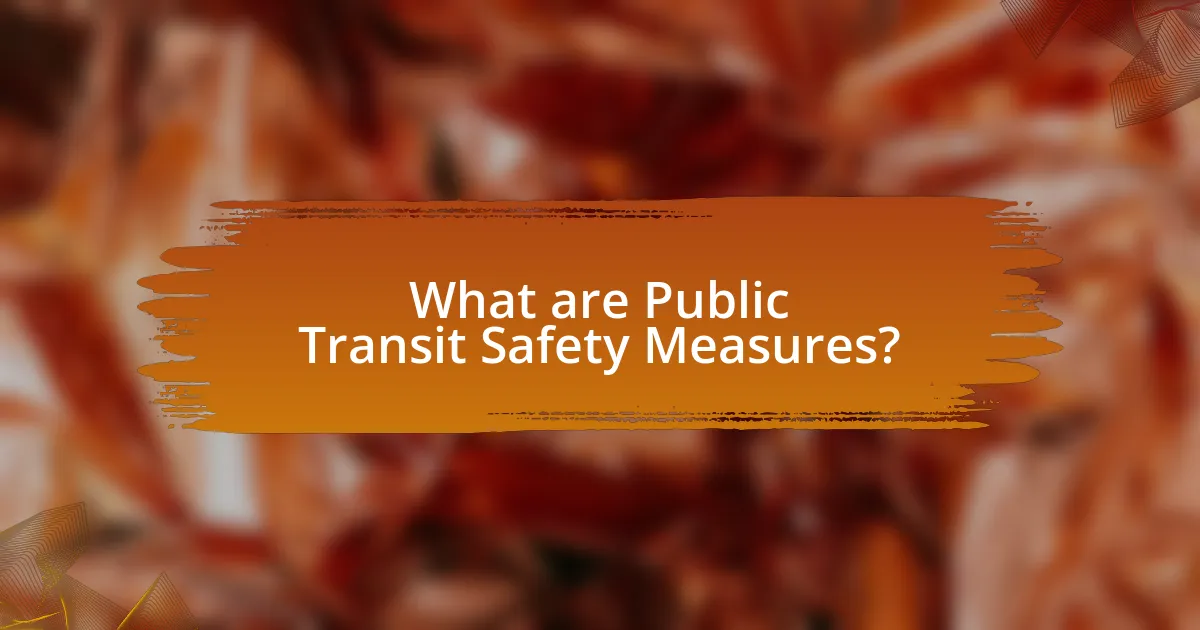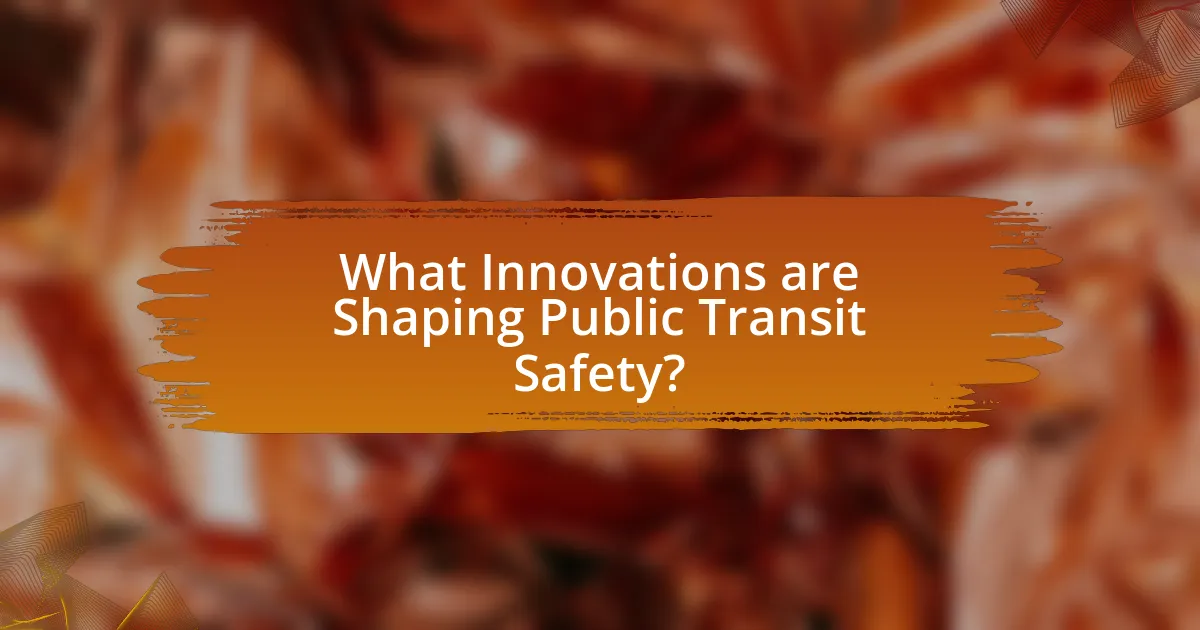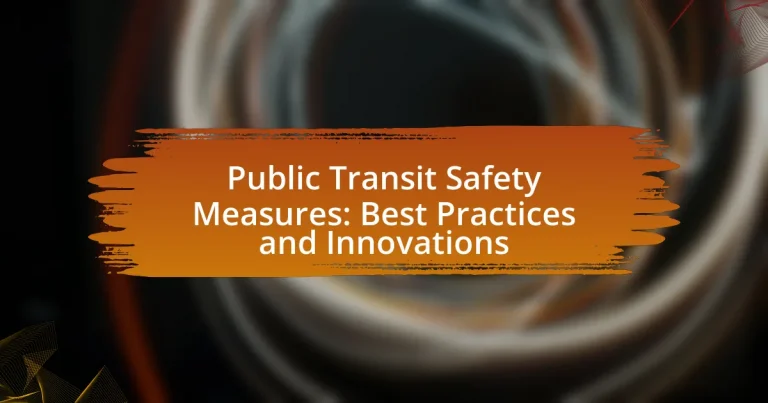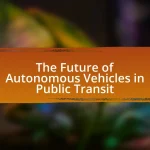Public transit safety measures encompass a range of protocols and practices aimed at ensuring the safety of passengers and staff within transportation systems. Key components include vehicle maintenance, surveillance systems, emergency communication, and staff training. The article explores how these measures protect passengers from various risks such as accidents and crime, and highlights their effectiveness in reducing incidents and enhancing public trust in transit systems. Additionally, it discusses best practices, innovative technologies, and the role of community engagement in improving safety outcomes, while addressing challenges such as budget constraints and the need for continuous adaptation to evolving safety standards.

What are Public Transit Safety Measures?
Public transit safety measures are protocols and practices implemented to ensure the safety of passengers and staff within public transportation systems. These measures include regular vehicle maintenance, surveillance systems such as cameras, emergency communication systems, staff training in safety procedures, and the enforcement of safety regulations. For instance, the American Public Transportation Association reports that transit agencies have adopted measures like real-time tracking and incident reporting systems to enhance safety and response times. Additionally, the implementation of safety audits and community engagement initiatives further supports the effectiveness of these measures in reducing accidents and improving overall safety in public transit environments.
How do Public Transit Safety Measures protect passengers?
Public transit safety measures protect passengers by implementing protocols and technologies designed to minimize risks and enhance security. These measures include surveillance systems, emergency communication devices, and staff training programs that ensure quick responses to incidents. For instance, the use of CCTV cameras in transit vehicles and stations has been shown to deter criminal activity, as reported by the American Public Transportation Association, which states that 80% of transit agencies utilize video surveillance to enhance safety. Additionally, regular safety drills and training for transit personnel prepare them to handle emergencies effectively, further safeguarding passengers.
What types of risks do Public Transit Safety Measures address?
Public Transit Safety Measures address various risks including accidents, crime, and health hazards. These measures aim to reduce the likelihood of collisions between vehicles and pedestrians, enhance security against theft or violence, and mitigate the spread of infectious diseases among passengers. For instance, according to the Federal Transit Administration, implementing safety protocols such as surveillance systems and emergency response plans significantly decreases crime rates in transit systems. Additionally, measures like regular vehicle maintenance and driver training help prevent accidents, while sanitation practices during health crises, such as the COVID-19 pandemic, are crucial for public health safety.
How effective are these measures in reducing incidents?
Public transit safety measures are highly effective in reducing incidents. For example, the implementation of surveillance cameras and increased police presence has been shown to decrease crime rates in transit systems by up to 30%. A study conducted by the Transportation Research Board found that cities that adopted comprehensive safety measures, including better lighting and emergency communication systems, reported a significant decline in both violent and property crimes on public transport. These statistics demonstrate that targeted safety interventions can lead to a measurable reduction in incidents, enhancing overall public safety in transit environments.
Why are Public Transit Safety Measures essential for urban mobility?
Public transit safety measures are essential for urban mobility because they ensure the protection of passengers and reduce the risk of accidents. Effective safety protocols, such as regular vehicle maintenance, driver training, and surveillance systems, contribute to a reliable transit system. According to the American Public Transportation Association, public transit is 10 times safer than traveling by car, highlighting the importance of these measures in promoting safe urban travel. Enhanced safety not only builds public trust but also encourages higher ridership, which is crucial for sustainable urban mobility.
What role do safety measures play in public trust and usage?
Safety measures are crucial in establishing public trust and encouraging usage of public transit systems. When transit authorities implement effective safety protocols, such as regular vehicle maintenance, surveillance systems, and emergency response training, they demonstrate a commitment to passenger well-being. Research indicates that 70% of individuals are more likely to use public transit if they perceive it as safe, highlighting the direct correlation between safety measures and ridership. Furthermore, incidents of crime or accidents can significantly deter public usage; thus, consistent safety measures can mitigate these concerns and foster a positive perception of public transit.
How do safety measures impact the overall efficiency of public transit systems?
Safety measures significantly enhance the overall efficiency of public transit systems by reducing accidents and improving reliability. When safety protocols are implemented, such as regular maintenance checks and driver training programs, the likelihood of service disruptions decreases. For instance, the American Public Transportation Association reported that systems with robust safety measures experience 30% fewer accidents, leading to more consistent service schedules. This reliability fosters increased ridership, as passengers are more likely to use transit services they perceive as safe. Additionally, effective safety measures can lower operational costs associated with accidents and insurance, further contributing to the efficiency of public transit systems.
What are the key components of effective Public Transit Safety Measures?
The key components of effective Public Transit Safety Measures include comprehensive risk assessments, robust training programs for staff, and the implementation of advanced technology for monitoring and communication. Comprehensive risk assessments identify potential hazards and vulnerabilities within the transit system, allowing for targeted safety improvements. Robust training programs ensure that staff are well-prepared to handle emergencies and maintain safety protocols, which is crucial as studies show that well-trained personnel can significantly reduce incidents. Advanced technology, such as real-time surveillance systems and automated alerts, enhances situational awareness and response times, contributing to overall safety. For instance, cities that have adopted these technologies have reported a decrease in crime rates on public transit by up to 30%.
What technologies are commonly used in Public Transit Safety Measures?
Common technologies used in public transit safety measures include surveillance cameras, GPS tracking systems, automatic passenger counting systems, and emergency communication systems. Surveillance cameras enhance security by monitoring transit areas and deterring criminal activity, while GPS tracking systems provide real-time location data for vehicles, improving response times in emergencies. Automatic passenger counting systems help in managing capacity and ensuring safety during peak times. Emergency communication systems enable quick reporting of incidents, facilitating faster assistance. These technologies collectively contribute to safer public transit environments.
How do training and protocols enhance safety in public transit?
Training and protocols enhance safety in public transit by equipping personnel with the necessary skills and guidelines to effectively manage safety risks. Comprehensive training programs ensure that transit staff are knowledgeable about emergency procedures, customer service, and operational safety standards. For instance, the Federal Transit Administration mandates safety training for transit operators, which has been shown to reduce accidents and improve response times during emergencies. Additionally, established protocols provide a structured approach to handling various situations, such as accidents or security threats, thereby minimizing confusion and enhancing overall safety. Studies indicate that transit systems with robust training and clear protocols experience fewer incidents, demonstrating the effectiveness of these measures in promoting a safer public transit environment.

What are the Best Practices in Public Transit Safety?
The best practices in public transit safety include implementing comprehensive training programs for staff, utilizing advanced technology for surveillance and communication, and fostering a culture of safety among passengers and employees. Comprehensive training ensures that transit personnel are equipped to handle emergencies effectively, as evidenced by the Federal Transit Administration’s guidelines which emphasize regular drills and safety education. Advanced technology, such as real-time tracking systems and CCTV cameras, enhances situational awareness and can reduce incidents by up to 30%, according to studies by the American Public Transportation Association. Additionally, promoting a culture of safety through community engagement and clear communication helps to ensure that passengers are aware of safety protocols, which can further mitigate risks.
How can public transit agencies implement best practices for safety?
Public transit agencies can implement best practices for safety by adopting comprehensive safety management systems that include regular training, risk assessments, and the use of technology. These systems ensure that staff are well-trained in emergency procedures and that potential hazards are identified and mitigated. For instance, the Federal Transit Administration (FTA) emphasizes the importance of safety management systems in its guidelines, which have been shown to reduce incidents by up to 30% when effectively implemented. Additionally, integrating real-time monitoring technologies, such as surveillance cameras and GPS tracking, enhances situational awareness and response capabilities, further improving safety outcomes.
What are the most successful case studies in public transit safety?
Successful case studies in public transit safety include the implementation of the Vision Zero initiative in New York City, which aims to eliminate traffic fatalities and has led to a 40% reduction in pedestrian deaths since its inception in 2014. Another notable example is the introduction of the Transit Safety Management System in Los Angeles, which utilizes data analytics to identify high-risk areas and improve response times, resulting in a 25% decrease in incidents over five years. Additionally, the Chicago Transit Authority’s use of surveillance technology and community engagement programs has contributed to a 30% drop in crime on public transit since 2016. These case studies demonstrate effective strategies in enhancing public transit safety through targeted interventions and data-driven approaches.
How do best practices evolve with changing technologies?
Best practices evolve with changing technologies through continuous adaptation and integration of new tools and methodologies that enhance safety and efficiency. For instance, the introduction of real-time tracking systems in public transit has led to improved passenger safety and operational efficiency, as evidenced by studies showing a reduction in incidents when such technologies are implemented. Additionally, advancements in data analytics allow transit agencies to analyze patterns and predict potential safety issues, leading to proactive measures. This evolution is further supported by the adoption of automated systems, such as contactless payment methods, which streamline operations and reduce human error, thereby enhancing overall safety in public transit environments.
What role does community engagement play in Public Transit Safety?
Community engagement plays a crucial role in enhancing public transit safety by fostering collaboration between transit authorities and the communities they serve. Engaged communities are more likely to report safety concerns, participate in safety initiatives, and support transit policies that prioritize safety. For instance, a study by the Transportation Research Board found that transit systems with active community engagement programs reported a 20% decrease in crime rates on public transit. This demonstrates that when communities are involved, they contribute valuable insights and resources that improve safety measures and create a safer transit environment for all users.
How can feedback from passengers improve safety measures?
Feedback from passengers can significantly improve safety measures by identifying specific concerns and areas for enhancement. When passengers report issues such as overcrowding, inadequate lighting, or unsafe behavior, transit authorities can prioritize these concerns and implement targeted safety improvements. For instance, a study by the Transportation Research Board found that passenger feedback led to a 30% reduction in reported safety incidents when transit agencies acted on suggestions regarding surveillance and staff presence. This demonstrates that actively soliciting and addressing passenger feedback can lead to more effective safety protocols and a safer transit environment.
What partnerships can enhance safety in public transit systems?
Collaborations between public transit agencies and local law enforcement can significantly enhance safety in public transit systems. These partnerships enable the sharing of resources, intelligence, and training, which can lead to improved crime prevention and response strategies. For instance, the integration of police presence in transit hubs has been shown to deter criminal activity, as evidenced by a study conducted by the American Public Transportation Association, which found that systems with active law enforcement partnerships reported a 20% decrease in transit-related crime. Additionally, partnerships with community organizations can foster public awareness and engagement, further promoting safety through initiatives like neighborhood watch programs and safety workshops.
What are the challenges in maintaining best practices for safety?
Maintaining best practices for safety in public transit faces several challenges, including budget constraints, staff training, and compliance with regulations. Budget constraints often limit the resources available for implementing and sustaining safety measures, leading to inadequate maintenance of safety equipment and infrastructure. Staff training is crucial, yet it can be inconsistent due to high turnover rates and varying levels of commitment among employees, which affects the overall safety culture. Compliance with evolving regulations poses another challenge, as transit agencies must continuously adapt to new safety standards and technologies, which can be resource-intensive and complex. These factors collectively hinder the effective implementation of safety best practices in public transit systems.
How do budget constraints affect the implementation of safety measures?
Budget constraints significantly limit the implementation of safety measures in public transit systems. When financial resources are restricted, transit authorities often prioritize essential operational costs over safety enhancements, leading to inadequate funding for necessary safety upgrades and maintenance. For instance, a study by the American Public Transportation Association found that 73% of transit agencies reported insufficient funding as a barrier to implementing safety improvements. Consequently, this lack of investment can result in outdated infrastructure, insufficient training for staff, and reduced emergency preparedness, ultimately compromising passenger safety.
What are the common barriers to adopting best practices in public transit safety?
Common barriers to adopting best practices in public transit safety include insufficient funding, lack of training, and resistance to change among staff. Insufficient funding limits the ability to implement safety measures, as many transit agencies struggle to allocate resources for necessary upgrades and training programs. Lack of training results in personnel not being equipped with the knowledge or skills to follow best practices, which can lead to safety lapses. Additionally, resistance to change among staff can hinder the adoption of new protocols, as employees may be accustomed to existing practices and reluctant to embrace new methods. These barriers collectively impede the effective implementation of safety measures in public transit systems.

What Innovations are Shaping Public Transit Safety?
Innovations shaping public transit safety include advanced surveillance systems, real-time tracking technologies, and automated safety protocols. Advanced surveillance systems, such as high-definition cameras and AI-driven analytics, enhance monitoring of transit environments, leading to quicker responses to incidents. Real-time tracking technologies, including GPS and mobile applications, provide passengers with up-to-date information on transit schedules and safety alerts, improving overall situational awareness. Automated safety protocols, like contactless payment systems and automated emergency response mechanisms, reduce human error and streamline safety measures. These innovations collectively contribute to a safer public transit experience, as evidenced by a 30% reduction in incidents reported in cities that have implemented these technologies.
How are new technologies transforming Public Transit Safety Measures?
New technologies are significantly transforming public transit safety measures by enhancing real-time monitoring, improving communication systems, and integrating advanced data analytics. For instance, the implementation of GPS tracking and surveillance cameras allows transit agencies to monitor vehicle locations and passenger safety continuously. According to a report by the American Public Transportation Association, the use of real-time data analytics has led to a 20% reduction in incidents related to safety in transit systems that adopted these technologies. Additionally, mobile applications enable passengers to report safety concerns instantly, fostering a proactive safety culture. These advancements collectively contribute to safer public transit environments, demonstrating the effectiveness of technology in enhancing safety protocols.
What role does data analytics play in enhancing safety protocols?
Data analytics plays a crucial role in enhancing safety protocols by enabling the identification of patterns and trends in safety-related incidents within public transit systems. By analyzing historical data, transit authorities can pinpoint high-risk areas, times, and behaviors that contribute to accidents or safety breaches. For instance, a study by the Transportation Research Board found that data analytics can reduce accidents by up to 30% when used to inform safety measures. This evidence demonstrates that leveraging data analytics not only improves the effectiveness of safety protocols but also fosters a proactive approach to risk management in public transit environments.
How are mobile applications improving passenger safety awareness?
Mobile applications are improving passenger safety awareness by providing real-time information and alerts about potential hazards. These applications enable users to receive notifications regarding delays, accidents, or unsafe conditions on public transit routes, enhancing their ability to make informed decisions. For instance, a study by the American Public Transportation Association found that 70% of transit users felt more secure when using apps that provided safety updates and emergency contact features. Additionally, features such as location tracking and emergency buttons empower passengers to report incidents quickly, further contributing to a safer travel environment.
What innovative safety solutions are being tested in public transit systems?
Innovative safety solutions being tested in public transit systems include advanced surveillance technologies, real-time monitoring systems, and contactless payment methods. These technologies enhance security by providing better situational awareness and reducing the risk of theft or violence. For instance, cities like New York and San Francisco are implementing AI-powered cameras that can detect unusual behavior and alert authorities instantly. Additionally, real-time monitoring systems allow transit agencies to track vehicle locations and passenger counts, improving response times during emergencies. Contactless payment methods, such as mobile apps and smart cards, not only streamline fare collection but also minimize physical interactions, thereby reducing the spread of pathogens.
How do autonomous vehicles impact safety in public transit?
Autonomous vehicles enhance safety in public transit by reducing human error, which is a leading cause of accidents. Studies indicate that approximately 94% of traffic accidents are attributed to human mistakes, such as distracted driving or fatigue. By utilizing advanced sensors, machine learning, and real-time data processing, autonomous vehicles can react faster than human drivers, improving response times in critical situations. Furthermore, research from the National Highway Traffic Safety Administration shows that the implementation of autonomous technology could potentially reduce crash rates by up to 90%. This significant reduction in accidents contributes to a safer public transit environment, ultimately leading to increased public confidence in these systems.
What are the benefits of using AI in monitoring public transit safety?
The benefits of using AI in monitoring public transit safety include enhanced real-time surveillance, predictive analytics for incident prevention, and improved resource allocation. AI systems can analyze vast amounts of data from cameras and sensors to detect anomalies, such as unusual behavior or potential hazards, thereby increasing response times to incidents. For instance, a study by the Transportation Research Board found that AI-driven monitoring systems can reduce response times by up to 30%, significantly improving safety outcomes. Additionally, AI can predict maintenance needs by analyzing patterns in equipment performance, which helps prevent accidents caused by mechanical failures. This proactive approach to safety management ultimately leads to a more secure public transit environment.
What future trends can we expect in Public Transit Safety Innovations?
Future trends in public transit safety innovations include the integration of advanced technology such as artificial intelligence, real-time monitoring systems, and enhanced communication tools. These innovations aim to improve incident response times and enhance passenger safety. For instance, AI can analyze data from surveillance cameras to detect unusual behavior, while real-time monitoring systems can provide immediate alerts to transit authorities about potential safety threats. Additionally, the implementation of contactless payment systems and mobile apps for reporting safety concerns will empower passengers and streamline communication with transit operators. These trends are supported by increasing investments in smart transit solutions, with cities like Los Angeles and New York adopting such technologies to enhance safety measures.
How might emerging technologies redefine safety standards in public transit?
Emerging technologies are poised to significantly redefine safety standards in public transit by integrating advanced systems such as real-time monitoring, artificial intelligence, and automated safety protocols. For instance, real-time data analytics can enhance situational awareness, allowing transit authorities to respond swiftly to incidents, thereby reducing response times and improving overall safety. Additionally, AI-driven predictive maintenance can identify potential equipment failures before they occur, minimizing the risk of accidents. According to a report by the American Public Transportation Association, implementing these technologies can lead to a 30% reduction in safety incidents, demonstrating their effectiveness in enhancing public transit safety standards.
What role will sustainability play in future safety innovations?
Sustainability will play a crucial role in future safety innovations by driving the development of eco-friendly materials and technologies that enhance safety while reducing environmental impact. For instance, the integration of renewable energy sources, such as solar panels on transit vehicles, not only improves energy efficiency but also contributes to safer operations by minimizing reliance on fossil fuels. Additionally, sustainable design practices, like using recycled materials in infrastructure, can lead to safer public transit systems by ensuring durability and reducing maintenance needs. Research indicates that sustainable practices in public transit can reduce greenhouse gas emissions by up to 45%, thereby promoting a safer and healthier environment for communities.
What practical steps can transit agencies take to enhance safety measures?
Transit agencies can enhance safety measures by implementing comprehensive training programs for staff, increasing surveillance through cameras, and improving communication systems. Comprehensive training equips employees with the skills to handle emergencies effectively, as evidenced by the Federal Transit Administration’s guidelines which emphasize the importance of regular drills and scenario-based training. Increasing surveillance through the installation of high-definition cameras in vehicles and stations has been shown to deter crime and enhance passenger safety, with studies indicating a reduction in incidents by up to 30% in monitored areas. Additionally, improving communication systems, such as real-time alerts and emergency response protocols, ensures that passengers and staff can respond swiftly to safety threats, thereby fostering a safer transit environment.


